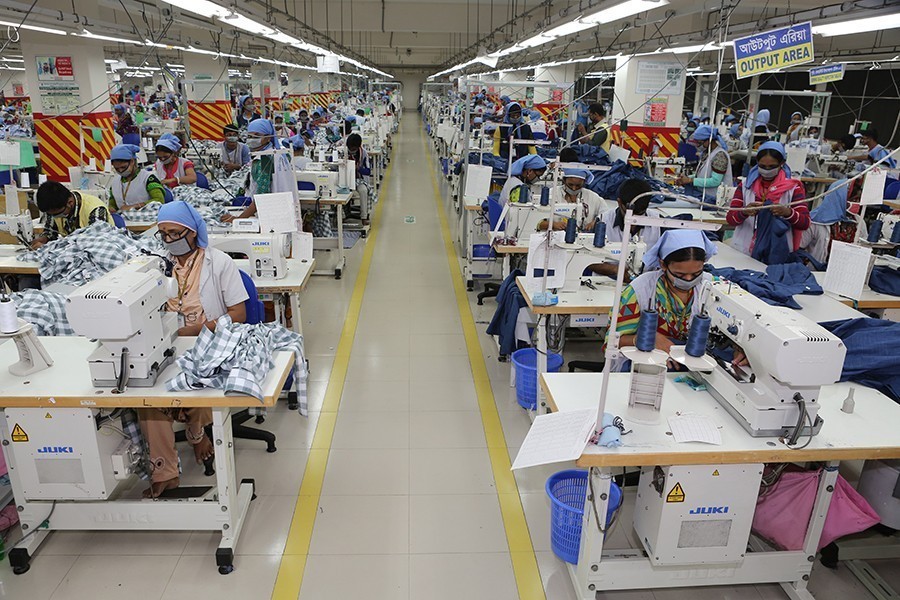
Published :
Updated :

The economic growth of Bangladesh, to a certain extent, depends on the export of apparels which account for approximately 80.0 per cent of the country's total annual export earnings. It also constitutes about 11.17 per cent of the country's Gross Domestic Product (GDP). The sector employs around 4.0 million people, where some 85.0 per cent is women. The export of apparels increased persistently during the last three decades, from US$ 868 million in FY91 to $34.13 billion in FY19.
The export-oriented industry's journey started in 1978 with 10,000 men's shirts worth 13 million Francs to a French company from Reaz Garments Ltd. However, Desh Garments Ltd was the first fully export-oriented garment factory in the country. In 1983, Bangladesh Garment Manufacturers and Exporters Association (BGMEA) was formed, which is now one of the country's largest trade associations representing the readymade garment industry. Today, the association collaborates with local and international stakeholders, including brands and development partners, to pave the way for developing the Bangladesh apparel industry. Currently, BGMEA has around four thousand registered garment factories.
The industry has grown quite rapidly and mostly in a structured way, and there were some setbacks also. The most devastating incident was the collapse of Rana Plaza in 2013, which caused the death of 1,150 garments workers. Following the 'Rana Plaza' collapse, international pressure to improve the factory's working conditions intensified. As a result, two international bodies, namely Accord ( an initiative of European retailers) and Alliance ( an initiative of North American buyers) emerged. These two bodies worked with Bangladesh to improve the working conditions and safety of the factory workers. As a result, many factories have improved the working conditions, health and workplace safety. Even some garments factories go green by setting up environment-friendly production units. A recent report by USGBC (LEED) showed that out of the top 27 environmental friendly establishments globally, 14 belong to Bangladeshi garments and textile factories. Better working condition and green factories enhance the image of the Bangladeshi clothing industry in the global market. BGMEA set a target of $50 billion export by 2021.
However, the outbreak of Covid-19 has already made the target quite uncertain, and it is necessary to revise it downward for the practical reason. On March 08, 2020, Bangladesh reported its' first positive case. After that, the government also declared public holidays which ended at the end of May 2020. As a result, the economic slowdown was quite apparent. Many Small garment factories were closed, and as the lockdown continued, some factory owners stopped making payment to their workers. To support the economic activities, the government allocated Tk 50 billion (approx. US$ 595.0 million) stimulus package for export-oriented industries including assistance towards salaries and funding of two-year loans to factory owners at 2.0 per cent interest. At the start of the pandemic, as China was not shipping its raw materials to the outside world, Bangladesh suffered as our country depends on China for backward linkage materials. This situation pushed smaller garments on the verge of extinction. Many small clothes did, and with these going down, workers working there have lost their jobs as well. Apart from this, leading buyers worldwide had banned shipments or cancelled a significant sum of orders.
Nevertheless, learning from past mistakes, more backward linkage garments manufacturers are now gradually coming up. It shows that there is a place for those units which manufacture chains, buttons etc. Banks are also coming forward in this endeavour. A reversal in adverse work orders is also helping to revive the industry and the economy gradually. A combined effort of the government, central bank, commercial banks and other stakeholders are now paying off. Besides disbursing the allocated stimulus money, the commercial banks have also offered a moratorium period to the borrowers to ease repayment pressure. Nevertheless, a long way is ahead to go before complete recovery.
Tapash Chandra Paul, PhD is Chief Financial Officer, Mercantile Bank Limited


 For all latest news, follow The Financial Express Google News channel.
For all latest news, follow The Financial Express Google News channel.